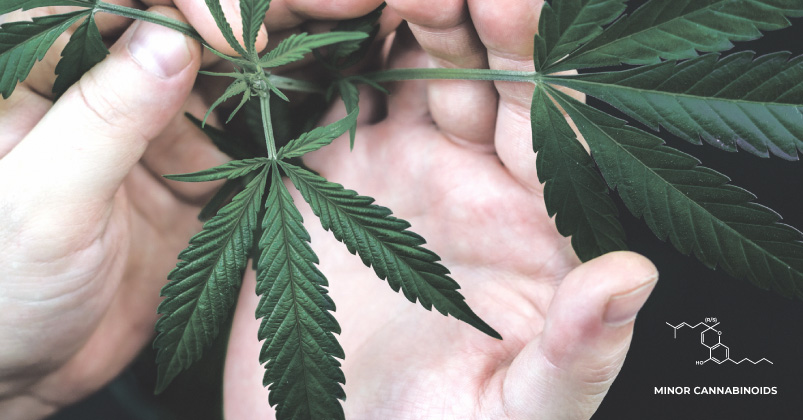Minor Cannabinoids: A Closer Look

CBC, CBN, and CBDV: What You Should Know About These Minor Cannabinoids
Scientists have found more than 500 components in cannabis plants, with over 100 of these identified as cannabinoids. Each of these phytocannabinoids has the potential to offer benefits to our health and wellness by interacting with our endocannabinoid system, helping us maintain balance and homeostasis.
Research into minor cannabinoids has been slow to progress, as more popular cannabinoids such as THC and CBD have taken much of the spotlight compared to the lesser-known compounds. These three phytocannabinoids may be known as “minor” but they have the potential to offer mighty benefits!
CANNABICHROMENE (CBC)

Cannabichromene, or CBC, originates from the same chemical as THC and CBD—CBGA. All cannabis plants produce cannabigerolic acid (CBGA), which breaks down into one of three lines: tetrahydrocannabinolic acid (THCA), cannabidiolic acid (CBDA), and cannabichromenic acid (CBCA), as directed by the enzymes in the plant’s glandular trichomes. CBCA then becomes CBC with exposure to UV light or heat, in a process known as decarboxylation.
CBC is the second most prominent cannabinoid found in marijuana and is non-intoxicating, considering that it binds poorly to CB1 and CB2 receptors. In some cases, CBC may make up as much as 64% of a plant’s cannabinoid profile. A 1975 study by Holley, Hadley, and Turner found that marijuana primarily contained higher concentrations of CBC than CBD, while hemp contained higher concentrations of CBD than CBC. CBC is also usually found to be in younger plants, as most growers breed their plants to have high CBD or THC levels.
What are the Benefits of CBC?
Although research is still at the beginning stages, preliminary studies have shown that CBC has the potential to offer many promising benefits. Researchers have noted that CBC binds to the TRPV1 and TRPA1 receptors–both of which are linked to pain perception. Activation of these receptors triggers a release of the body’s natural endocannabinoids such as anandamide, increasing production and activity at CB1 receptors.
In addition to releasing this naturally-occurring cannabinoid, CBC appears to inhibit the breakdown of anandamide, keeping it active in the bloodstream for a longer period of time. While CBC has its own benefits, researchers believe that it works most synergistically with other cannabinoids in a phenomenon called the “entourage effect.”
CBC achieves this by interfering with processes that break down cannabinoids and enhances the receptor activity of phytocannabinoids. Early research, anecdotal evidence, and animal studies show that CBC may be a viable treatment for a range of diseases and illnesses. Here’s what we currently understand about CBC’s potential therapeutic applications.
CBC and Cancer
Due to its interaction with anandamide, CBC may have the potential to be a powerful cancer fighter. Anandamide has been shown to fight breast cancer growth in vitro, as well as in living organisms by inhibiting the development of new blood vessels in malignant growths. In theory, CBC may play a role in suppressing or reversing the progression of cancer cells.
CBC’s role as a potential cancer fighter was first published in a 2006 study, which looked at the effects of cannabinoids other than THC on malignant breast cancer cells. This study revealed that CBD was the most potent inhibitor of cancer cell growth, followed by CBG and CBC.
CBC and Pain & Inflammation
A 1980 rodent study showed that CBC on its own was as effective as the nonsteroidal anti-inflammatory drug (NSAID) Phenylbutazone. However, CBC has been revealed to be the most effective when used with other cannabinoids like CBD or THC.
In a 2011 study, CBC in combination with THC had significant anti-inflammatory response with a much greater effect on inflammation than by either cannabinoid on their own.
CBC and Healthy Brain Function
A 2013 study revealed that CBC has a positive effect on neurogenesis and can contribute to healthy brain function. Neural stem progenitor cells (NSPCs) become more viable in the presence of CBC. These cells divide to produce astroglial cells, which are crucial for maintaining homeostasis within the brain.
Astroglial cells regulate the formation and stability of synapses and perform a variety of functions, including neurotransmitter direction and defending against oxidative stress. The defensive capabilities of astroglia can also determine the progression and outcome of neurological disease, such as dementia and Alzheimer’s disease.
CBC and Acne
Researchers believe that CBC may be a powerful anti-acne agent. Acne is caused by excess oil (sebum) production and typically appears in areas of the skin that have the most oil (sebaceous) glands. The anti-inflammatory properties of CBC may soothe over productive sebaceous glands and suppress excessive lipid production.
CANNABINOL (CBN)
 Cannabinol, or CBN, was the first cannabinoid to be discovered by scientists. When it was first isolated at the end of the 19th century, it was believed that it was responsible for the marijuana “high”. However, on its own, CBN exhibits little to no psychoactive effects. CBN is created as THC ages and is exposed to oxygen, so it is most often found in older cannabis. Like THC, CBN also binds to CB1 receptors, but at a much lower strength. This may give CBN similar, if much milder, effects as THC.
Cannabinol, or CBN, was the first cannabinoid to be discovered by scientists. When it was first isolated at the end of the 19th century, it was believed that it was responsible for the marijuana “high”. However, on its own, CBN exhibits little to no psychoactive effects. CBN is created as THC ages and is exposed to oxygen, so it is most often found in older cannabis. Like THC, CBN also binds to CB1 receptors, but at a much lower strength. This may give CBN similar, if much milder, effects as THC.
What are the Benefits of CBN?
Like CBC, CBN has also been shown to be very effective when used in combination with other cannabinoids. However, CBN may offer a host of unique benefits as well. As with all cannabinoids, this research is extremely preliminary, however, initial studies suggest that CBN may play a role in regulating the following systems within the body.
CBN and Healthy Brain Function
CBN may be a powerful neuroprotectant, shielding nerve cells against damage, degeneration, and impairment of function. When used as a treatment for ALS in rodents, researchers found that it was able to delay the onset of the condition. While this study was limited to rodents, this suggests that future human studies may reveal CBN to be a powerful tool in the treatment of ALS and other neurodegenerative diseases.
CBN and Glaucoma
CBN has been found to reduce intraocular pressure, which can damage the nerve connecting the eye to the brain, resulting in glaucoma which may cause blindness over time. In 1984, a study on cats with glaucoma revealed that chronic CBN use caused a reduction in this pressure. Another study on rabbits found that CBN (as well as THC) reduces intraocular pressure, reducing the risk of glaucoma and blindness.
CBN and Sleep
CBN has traditionally been thought of by marijuana connoisseurs as a super-sedative, but a very small 1975 study found that isolated CBN didn’t make subjects sleepy on its own. In this study, researchers tested isolated CBN, CBN with THC, and isolated THC. While THC produced some drowsiness on its own, the combination of the two produced even higher levels of sedation.
It’s important to note that older cannabis is believed to have higher levels of sedating scent molecules, or terpenes. These terpenes, combined with THC and CBN, could also account for the sedative effects of older marijuana strains.
CBN and Pain & Inflammation
In a 2016 study, CBN, along with CBD and CBC, reduced collagen-induced arthritis, revealing that it may offer potent anti-inflammatory benefits and be capable of helping those with rheumatoid arthritis. A 2019 study showed that CBN also has the potential to provide analgesic relief. In another example of the entourage effect, this study also revealed that while CBN and CBD reduced sensitivity on their own, when combined, the effect was much greater.
CBN and Appetite
CBN also performs similarly to THC in regard to appetite. In one study, it was found to increase the amount of food that rat subjects ate, suggesting that it could be an effective appetite stimulant. This cannabinoid may offer an alternative for those seeking appetite stimulation without the THC “high”.
CANNABIDIVARIN (CBDV)

Cannabidivarin or (CBDV) was first identified in 1969 and only recently has become a subject of research. CBDV shares a similar molecular structure to CBD and, like CBD, is also not psychoactive when isolated. It’s also generally found in plants with a higher amount of CBD and lower amounts of THC. CBDV has mostly been found in strains sourced from Asia and Africa, but have recently been found in northwest India, Pakistan, and Mexico.
What are the Benefits of CBDV?
Since this cannabinoid is still so new to the scientific community, there isn’t extensive research on CBDV just yet. However, much of the research available has centered on CBDV’s effect on seizures and other neurological disorders. CBDV appears to affect the neurochemical pathway of capsaicin receptors involved in the onset and progression of several types of epilepsy.
The creator of the first FDA-approved CBD drug, Epilodex, is currently developing a CBDV-based drug known as GPW42006, which is designed to reduce or prevent epilepsy and seizures. CBDV may also help restore sociability and motor coordination issues associated with Rett syndrome, an X chromosome mutation that causes seizures, speech issues, and muscle spasticity.
CBDV may also help those with Duchenne muscular dystrophy (or DMD), according to a 2019 animal study. DMD is characterized by chronic inflammation and irreversible skeletal muscle damage and degeneration.
CBDV has been found to improve mobility, reduce inflammation and allow the body’s cells to “clean out” any damaged components. CBDV is also being researched as a potential treatment of many issues caused by Autism. Another 2019 study showed that the administration of CBDV to symptomatic rats helped reduce repetitive behavioral problems, difficulties with social functioning, short-term memory deficits, repetitive behaviors, and hyperlocomotion.
While research into these cannabinoids suggests many possible treatments for a range of illnesses and disorders, further studies and human trials are needed to confirm the validity of these predictions. There’s one thing we know to be completely true–this plant is absolutely incredible. With over 100 other cannabinoids such as Cannabigerol (CBG) to explore, we predict that researchers will be very busy in years to come as they delve further into the life-changing benefits of minor cannabinoids.
Other Sources:
- leafly.com/news/cannabis-101/what-is-cannabichromene-cbc-cannabinoid
- weedmaps.com/learn/cbd/cbn-vs-cbd
- leafly.com/news/science-tech/what-is-cbn-and-what-are-the-benefits-of-this-cannabinoid
- analyticalcannabis.com/articles/beyond-cbd-exploring-the-health-benefits-of-cbn-311488
- hightimes.com/health/science/cbdv-cannabidivarin/
